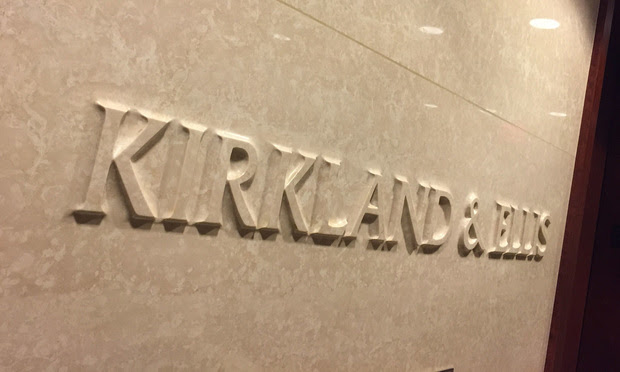What Is the 'New Normal' for Kirkland & Ellis?
Latham & Watkins didn't have much time to enjoy being the first firm to shatter the $3 billion gross revenue mark in the Am Law 100. Kirkland, and its incredible growth rate, also joined that exclusive club last year.
March 22, 2018 at 09:00 PM
7 minute read
In this week's Law Firm Disrupted, we revisit a pre- and post-recession financial analysis of the world's two largest law firms by gross revenue.
I'm Roy Strom, a reporter for ALM and the author of this post-last-recession, pre-next-recession newsletter. Please reach out and tell me what you think at [email protected].
Want to receive The Law Firm Disrupted as a weekly email? Sign up here.
 Almost a month ago today, I wrote a news story about Latham & Watkins becoming the first firm to cross the $3 billion gross revenue threshold in the history of the Am Law 100.
Almost a month ago today, I wrote a news story about Latham & Watkins becoming the first firm to cross the $3 billion gross revenue threshold in the history of the Am Law 100.
It was true at the time! (At least judged by a timeline of our reporting.)
Then, a day after the news of Latham's revenue record, I wrote a column here putting Latham's and Kirkland & Ellis' revenue growth since 2008 in context with their pre-recession growth rates.
The takeaway was something like this: Even though they are two of the most successful firms in the Am Law 100, Latham and Kirkland are still operating in a world of lessened expectations (and growth rates) since the financial crisis.
It was true at the time!
But a data point was missing that I did not expect to be as significant as it proved to be: Kirkland's 2017 revenue growth. Well, the data point is in, and it's big.
Yesterday I wrote a story reporting that Kirkland also breached the $3 billion barrier last year after growing its top line by 19.4 percent. Kirkland also topped Latham's revenue figure: $3.165 billion to $3.064 billion. Kirkland declined to comment on its 2017 finances.
In my previous column, we compared growth rates from the firms' latest revenue figures to 2008 and then back roughly the same number of years from 2008 (in Kirkland's case, the data went to fiscal 2000; in Latham's, 1999).
Here are Latham's numbers again: In the pre-recession era, revenue at the firm rose 230 percent. In the post-recession era, that number is a more modest 59 percent.
Here are Kirkland's new numbers: In the pre-recession era, revenue rose 241 percent. In the post-recession era, that number is 126 percent.
For comparison's sake, here are the Am Law 100 numbers again: From 2009 to 2017, the revenue of Am Law 100 firms grew 29 percent. From 2001 to 2009, that figure grew 117 percent.
Over that longer-term comparison, the lesson holds the same: Kirkland and Latham are not growing as fast as they once did (boo-hoo). But Kirkland's last two years suggest that may not still be the case at a firm that now has top-tier practices in M&A, restructuring, private equity and litigation.
In the past two years, Kirkland has grown revenue by 15 percent and 19 percent, respectively. That 19 percent growth rate is the biggest single-year growth rate the firm has seen since at least 2000. Maybe ever. And the firm's two-year growth rate of 37.3 percent is also the most growth Kirkland has experienced in any two-year period dating back as far.
That is right back in line with Kirkland's heyday of growth: From fiscal 2004 to 2006, the firm's revenue rose 37.1 percent. From 2003 to 2005; 33.8 percent. From 2002 to 2004; 36.7 percent. And it goes on like that for another couple of years back into the good old days.
For comparison's sake, Latham has not enjoyed a similar reunion tour of days gone by. From fiscal 2015 to 2017, Latham's revenue rose 15.6 percent. That's nothing to scoff at!
But nothing like what its more vintage partners may remember. From fiscal 2005 to 2007, Latham's revenue rose 42 percent. That wasn't really an aberration. In the pre-recession era, Latham's two-year growth rates never dipped below 32 percent.
But the broader point is this: Kirkland has done something over the past two years that most legal market observers would say could not be done. It has shown it is not beholden to the “new normal.” At least for now.
Roy's Reading Corner:
On Law Department Outsourcing: UnitedLex is at it again, as my colleague Miriam Rozen reports. The legal outsourcing company that likens itself to management consultancy Accenture announced a deal Thursday with General Electric to deliver lawyers and technology to optimize GE's legal operations, litigation and investigations support functions. The deal, which focuses on electronic discovery, forensics and document review, is said to reduce GE's legal spend by 30 percent in those areas.
That amounts to roughly $40 million to $50 million a year, a source told Rozen. As part of the deal, GE will “repurpose” up to 75 lawyers with some transitioning to UnitedLex, Rozen reports. UnitedLex CEO Dan Reed said the deals with in-house departments that his company is making “renders traditional models obsolete.”
From Reed: “We have a lot invested in the evolution of the law business and we have a long-term view of it.”
On Innovating in Big Law: Not too long ago, Akerman was applauded for a tool that automated legal advice related to data breach notification requirements. Called the Akerman Data Law Center, it launched in 2015 and was a truly novel approach for Big Law. It was an example of a law firm collaborating to provide expertise in a less-expensive and more-convenient fashion.
But it remains a challenge for large firms that want to innovate in that way, as seen most recently by two Akerman partners I reported on who worked on the Data Law Center and were leaving to form their own firm. Under their own roof, they say, it will be easier to develop the type of “expert systems” they think the Data Law Center was a great example of. Mainly, they won't struggle to figure out how to compensate lawyers for spending time working on a product rather than billing hours.
On People Hating Machines: This week, an autonomous vehicle being tested by Uber Technologies Inc. struck and killed a woman in Tempe, Arizona. Uber will likely face litigation, if a survey by law firm Miller, Canfield, Paddock and Stone and J.D. Power is any indication. The survey found nearly 55 percent of respondents would sue if they were in an accident with a fully automated vehicle, compared to about 35 percent who would sue a regular human driver.
It may not mean much for law firms on its face, but there is a broader issue: Who is liable when a computer is trusted to do thing that humans are often worse at doing? That is set to become a real issue for courts in a number of contexts, including possibly legal malpractice claims somewhere down the line. Humans seem to expect machines or robots to be perfect. And they will hold them to account for that.
That's it for this week! Reach out here: [email protected]. You can also sign up for this email briefing here. CORRECTION: A previous version of this column inaccurately attributed the source for the $40 million to $50 million in cost savings that GE expects to see through its deal with UnitedLex.
This content has been archived. It is available through our partners, LexisNexis® and Bloomberg Law.
To view this content, please continue to their sites.
Not a Lexis Subscriber?
Subscribe Now
Not a Bloomberg Law Subscriber?
Subscribe Now
NOT FOR REPRINT
© 2025 ALM Global, LLC, All Rights Reserved. Request academic re-use from www.copyright.com. All other uses, submit a request to [email protected]. For more information visit Asset & Logo Licensing.
You Might Like
View All
Global Lawyer: Big Law Walks a Tightrope But Herbert Smith Freehills Refuses to Lose Its Footing
8 minute readTrending Stories
Who Got The Work
J. Brugh Lower of Gibbons has entered an appearance for industrial equipment supplier Devco Corporation in a pending trademark infringement lawsuit. The suit, accusing the defendant of selling knock-off Graco products, was filed Dec. 18 in New Jersey District Court by Rivkin Radler on behalf of Graco Inc. and Graco Minnesota. The case, assigned to U.S. District Judge Zahid N. Quraishi, is 3:24-cv-11294, Graco Inc. et al v. Devco Corporation.
Who Got The Work
Rebecca Maller-Stein and Kent A. Yalowitz of Arnold & Porter Kaye Scholer have entered their appearances for Hanaco Venture Capital and its executives, Lior Prosor and David Frankel, in a pending securities lawsuit. The action, filed on Dec. 24 in New York Southern District Court by Zell, Aron & Co. on behalf of Goldeneye Advisors, accuses the defendants of negligently and fraudulently managing the plaintiff's $1 million investment. The case, assigned to U.S. District Judge Vernon S. Broderick, is 1:24-cv-09918, Goldeneye Advisors, LLC v. Hanaco Venture Capital, Ltd. et al.
Who Got The Work
Attorneys from A&O Shearman has stepped in as defense counsel for Toronto-Dominion Bank and other defendants in a pending securities class action. The suit, filed Dec. 11 in New York Southern District Court by Bleichmar Fonti & Auld, accuses the defendants of concealing the bank's 'pervasive' deficiencies in regards to its compliance with the Bank Secrecy Act and the quality of its anti-money laundering controls. The case, assigned to U.S. District Judge Arun Subramanian, is 1:24-cv-09445, Gonzalez v. The Toronto-Dominion Bank et al.
Who Got The Work
Crown Castle International, a Pennsylvania company providing shared communications infrastructure, has turned to Luke D. Wolf of Gordon Rees Scully Mansukhani to fend off a pending breach-of-contract lawsuit. The court action, filed Nov. 25 in Michigan Eastern District Court by Hooper Hathaway PC on behalf of The Town Residences LLC, accuses Crown Castle of failing to transfer approximately $30,000 in utility payments from T-Mobile in breach of a roof-top lease and assignment agreement. The case, assigned to U.S. District Judge Susan K. Declercq, is 2:24-cv-13131, The Town Residences LLC v. T-Mobile US, Inc. et al.
Who Got The Work
Wilfred P. Coronato and Daniel M. Schwartz of McCarter & English have stepped in as defense counsel to Electrolux Home Products Inc. in a pending product liability lawsuit. The court action, filed Nov. 26 in New York Eastern District Court by Poulos Lopiccolo PC and Nagel Rice LLP on behalf of David Stern, alleges that the defendant's refrigerators’ drawers and shelving repeatedly break and fall apart within months after purchase. The case, assigned to U.S. District Judge Joan M. Azrack, is 2:24-cv-08204, Stern v. Electrolux Home Products, Inc.
Featured Firms
Law Offices of Gary Martin Hays & Associates, P.C.
(470) 294-1674
Law Offices of Mark E. Salomone
(857) 444-6468
Smith & Hassler
(713) 739-1250











